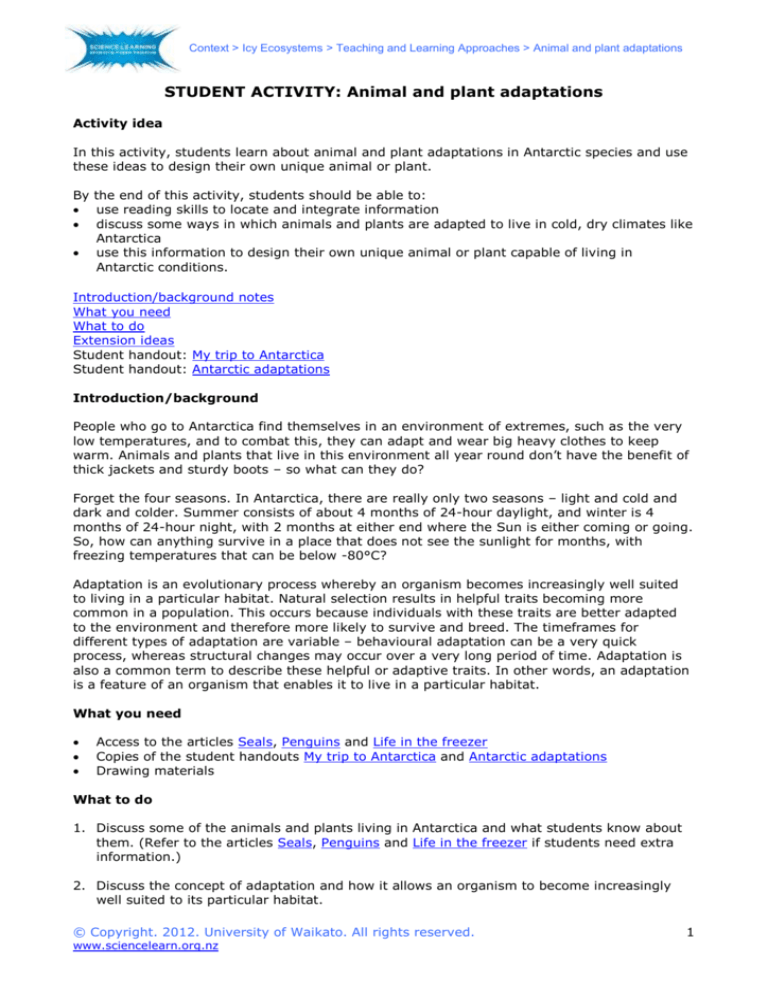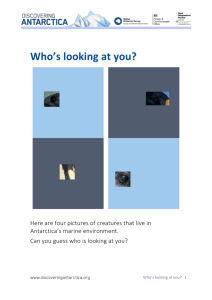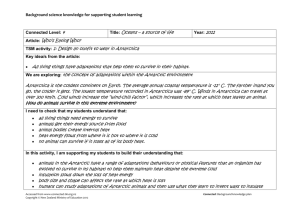
Context > Icy Ecosystems > Teaching and Learning Approaches > Animal and plant adaptations
STUDENT ACTIVITY: Animal and plant adaptations
Activity idea
In this activity, students learn about animal and plant adaptations in Antarctic species and use
these ideas to design their own unique animal or plant.
By the end of this activity, students should be able to:
use reading skills to locate and integrate information
discuss some ways in which animals and plants are adapted to live in cold, dry climates like
Antarctica
use this information to design their own unique animal or plant capable of living in
Antarctic conditions.
Introduction/background notes
What you need
What to do
Extension ideas
Student handout: My trip to Antarctica
Student handout: Antarctic adaptations
Introduction/background
People who go to Antarctica find themselves in an environment of extremes, such as the very
low temperatures, and to combat this, they can adapt and wear big heavy clothes to keep
warm. Animals and plants that live in this environment all year round don’t have the benefit of
thick jackets and sturdy boots – so what can they do?
Forget the four seasons. In Antarctica, there are really only two seasons – light and cold and
dark and colder. Summer consists of about 4 months of 24-hour daylight, and winter is 4
months of 24-hour night, with 2 months at either end where the Sun is either coming or going.
So, how can anything survive in a place that does not see the sunlight for months, with
freezing temperatures that can be below -80°C?
Adaptation is an evolutionary process whereby an organism becomes increasingly well suited
to living in a particular habitat. Natural selection results in helpful traits becoming more
common in a population. This occurs because individuals with these traits are better adapted
to the environment and therefore more likely to survive and breed. The timeframes for
different types of adaptation are variable – behavioural adaptation can be a very quick
process, whereas structural changes may occur over a very long period of time. Adaptation is
also a common term to describe these helpful or adaptive traits. In other words, an adaptation
is a feature of an organism that enables it to live in a particular habitat.
What you need
Access to the articles Seals, Penguins and Life in the freezer
Copies of the student handouts My trip to Antarctica and Antarctic adaptations
Drawing materials
What to do
1. Discuss some of the animals and plants living in Antarctica and what students know about
them. (Refer to the articles Seals, Penguins and Life in the freezer if students need extra
information.)
2. Discuss the concept of adaptation and how it allows an organism to become increasingly
well suited to its particular habitat.
© Copyright. 2012. University of Waikato. All rights reserved.
www.sciencelearn.org.nz
1
Context > Icy Ecosystems > Teaching and Learning Approaches > Animal and plant adaptations
3. Hand out copies of the student handouts My trip to Antarctica and Antarctic adaptations. As
they read about the trip, students record which adaptations the Antarctic visitor learned
about and which animals or plants have these adaptations. (With younger students or less
able readers, use an IWB to read through the My trip to Antarctica handout as a group,
annotating adaptations. Alternatively, the My trip to Antarctica handout is a Word
document that can be altered to suit your students’ needs.)
4. Discuss whether students think these animals could survive anywhere else in the world.
5. Design and draw an animal adapted to live in Antarctica, using labels to explain the
adaptations.
Extension ideas
The diary mentions that adaptations can be behavioural or structural. Adaptations can also be
physiological. Older students may like to explore these concepts. The articles Earthworm
adaptations, Adaptations of marine organisms and Native bird adaptations discuss the three
adaptation categories with reference to specific terrestrial and marine animals.
Humans live in Antarctica all year round. Discuss the following:
What allows us to live in Antarctica?
Are these adaptations?
How does this relate to human evolution?
© Copyright. 2012. University of Waikato. All rights reserved.
www.sciencelearn.org.nz
2
Context > Icy Ecosystems > Teaching and Learning Approaches > Animal and plant adaptations
Student handout: My trip to Antarctica
Day 1
Dear Diary, today I arrived in Antarctica. I am here for a week and staying with a group of
scientists at the Scott Base. Each day, I will get to go and see different animals and places,
and I am really excited about it. I’m hoping to write a little every day about what I do so that I
will be able to remember as much as I can about this adventure.
Day 2
Dear Diary, today I got to go out on the ice near the water’s edge. I was amazed at all the
animals I saw! First, we saw a huge orca that was in the water. We kept walking, and we saw
some seals lying on the ice, and it looked like they were sunbathing. That got me thinking, if I
was lying on the ice, I’d be freezing, so how is it that all these animals can handle such cold
temperatures?
I asked one of the scientists and he told me that the animals have adaptations – ways in which
their bodies and behaviours are modified to survive in this harsh environment. Some of the
adaptations were easy to spot (like feathers on penguins that help to keep them warm). Some
of the other adaptations were quite unusual, such as special chemicals in the blood of some
fish that stopped them from freezing.
Most of the animals down here have blubber, which is layers of fat that keep them warm. It
works just like the insulation we have in our houses back home to keep the heat in. In addition
to blubber, the birds have feathers, which they can puff up and trap air. Lots of the animals
have water-repelling fur or feathers so their coats don’t freeze.
Day 3
Dear Diary, well, there are lots of penguins down here, and they make a lot of noise. I found
out that their ‘tuxedos’ were a sort of camouflage. When a predator like a whale is in the water
and looks up, the white belly of the penguin blends in with the light from the sky above. The
reverse is true for looking down onto the black back of the penguin from above – the black
blends into the darkness. I thought that was cool but not as cool as how they keep their bodies
warm.
Penguins have blubber and feathers, but they also huddle in groups for body warmth. They
rock back on their heels and rest on their tails to keep their toes off the ice. But the most
interesting adaptation of all was a special aspect of the circulatory system called a countercurrent system. What happens is their veins (which carry the colder blood that is returning
from the feet and flippers back to the heart) wrap around the arteries (which carry warmer
blood from the heart to the limbs). By wrapping around, the colder blood gets warmed up and
the warmer blood gets cooled down. This clever system means that, despite the ice cold
environment, the penguins’ blood temperature doesn’t drop, and less heat is lost to the
environment, plus it keeps the penguins’ feet just above freezing point.
Day 4
Dear Diary, we didn’t go out today because the winds were too strong. I wonder if any of the
penguins got blown away. I know there are some Antarctic birds called terns that fly away and
go north during the winter so that they can avoid the harsh winter. Then they come back
during the summer. This is called migration. But penguins can’t fly, so I guess they would have
to stay in Antarctica or swim to warmer water. They would have to be really good swimmers
because it’s pretty far away.
© Copyright. 2012. University of Waikato. All rights reserved.
www.sciencelearn.org.nz
3
Context > Icy Ecosystems > Teaching and Learning Approaches > Animal and plant adaptations
Day 5
Dear Diary, well, I was right – some penguins do migrate by swimming. This is a behavioural
adaptation unlike lots of the other adaptations I have seen, which have been physiological.
We saw more seals today – we watched one disappear into the water and it didn’t come back
up! I was worried at first but then I learnt that some animals can slow down their heart rate
and breathing so that they don’t have to come up for air for ages. The Weddell seal can dive
600 metres deep and hold its breath for an hour. It can do this by collapsing its lung.
Day 6
Dear Diary, today we went and looked at plants. I didn’t think anything grew down here, but
we found all sorts of little plants living where there was no ice. They grew really close to the
ground and often in groups – this is to help them keep as much water as possible. They also
have cup-like leaves to trap the water. I learned that there is so little water in Antarctica that
it is regarded as a desert, and I guess when you grow in a desert, every drop of water
matters.
Tomorrow, we are leaving to go home. The week has gone really fast, and I’ve decided that I
want to come back to Antarctica soon.
© Copyright. 2012. University of Waikato. All rights reserved.
www.sciencelearn.org.nz
4
Context > Icy Ecosystems > Teaching and Learning Approaches > Animal and plant adaptations
Student handout: Antarctic adaptations
Fill in the table below, using the My trip to Antarctica diary to identify different adaptations
used by Antarctic animals and plants.
Adaptation
Animal/plant
© Copyright. 2012. University of Waikato. All rights reserved.
www.sciencelearn.org.nz
Function
5









